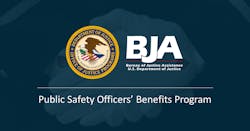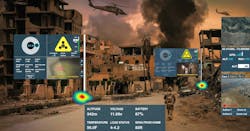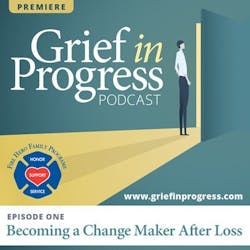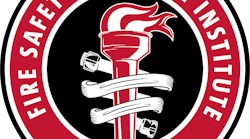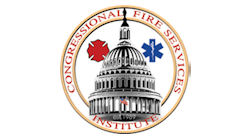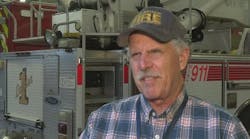Reform of Public Safety Officers’ Benefits Program
- Interim benefits increased to $6,000 from $3,000
- Payment amount adjusted to the time of award instead of the time of the incident
- Clarifies that public safety officers who qualify for disability benefits may undertake nominal work
- Includes eligibility for fire police officers who provide traffic control and incident-scene management
- Extends educational benefits to children of public safety officers who were born after the officer was disabled or died in the line of duty
- Retroactively provides benefits to public safety officers who were disabled when they responded to the Sept. 11 terrorist attacks
Teledyne FLIR won a development contract that’s worth as much as $15.7 million with the U.S. Defense Threat Reduction Agency’s Joint Science and Technology Office to develop novel battlefield threat-mapping and visualization tools. The tools will allow the capability to digitally map hazardous material threats from sensor data and to “see” their exact location via mixed reality on mobile phones, tablets and heads-up displays (HUDs).
Teledyne FLIR will work with partners to develop software that allows chemical, biological, radiological, and nuclear hazards to be precisely located, measured and mapped for viewing within the Tactical Assault Kit (TAK) suite of tools. The threat map will be visualized in a “see-through” augmented reality display by those who run TAK on their electronics as well as by futuristic HUD devices, such as the Integrated Visualization Augmentation System.
For more information, visit flir.com/threat-detection.
Line-of-Duty Deaths
11 U.S. firefighters recently died in the line of duty. Four firefighters died after they contracted COVID-19, four deaths were health-related, one firefighter was killed during fireground operations, one was hit and killed by a motor vehicle, and one died in a motor vehicle accident. This issue of Firehouse is dedicated to these firefighters. For the latest on COVID-19-related LODDs, visit firehouse.com/covid-19.
FIREFIGHTER TYRONE BELL, 35, of the Verde Valley Fire District in Cottonwood, AZ, died on Oct. 18. On Oct. 4, Bell responded to multiple EMS calls that involved patients who had a known case of COVID-19. Bell subsequently contracted the virus.
CAPT. WESLEY VANDERVER, 86, of the Sugar Hill Volunteer Fire Department in Mount Pleasant, TX, died on Oct. 27. Vanderver responded to a residential fire. While he worked pump operations, he suffered a heart attack. He was transported to the local hospital, where he died a short time later.
FIREFIGHTER GERALD A. BROOKS, 49, of the Indianapolis Fire Department, died on Nov. 2. On Oct. 22, Brooks responded to numerous EMS calls. He subsequently contracted COVID-19.
FIREFIGHTER BRANDON ROMO, 32, of the Pardeeville, WI, Fire Department, died on Nov. 6. On Oct. 6, while attending a department fundraiser, Romo contracted COVID-19.
ASST. CHIEF ROSS DARREN ESTABROOKS, 47, of the Tri-Lakes Volunteer Fire Department in Pittsburg, TX, died on Nov. 15. Estabrooks responded to a residential fire. While on scene, he suffered a heart attack. He was transported to the local hospital, where he died a short time later.
FIREFIGHTER/PARAMEDIC SCOTT WILLIAMS, 46, of the Argonne National Laboratory Fire Department in Lemont, IL, died on Nov. 21. Williams responded to a smoke investigation in one of the facility’s laboratories. He returned to the station. During shift change, he was found unresponsive in his bunk. He was pronounced dead at the scene. An investigation into the cause of his death is ongoing.
FIREFIGHTER KASEY CALLWOOD, 31, of the Virgin Islands Fire Service, died on Nov. 22. Callwood and another firefighter were returning to the fire station from a training exercise in a department apparatus when they were involved in a single-vehicle accident. The apparatus overturned, killing Callwood and injuring the other firefighter.
LT. DARIN DEAN PASOLD, 52, of the Hohenwald, TN, Fire Department, died on Nov. 27. On Oct. 15, Pasold responded to a motor vehicle accident, where he came in contact with the accident victim. He subsequently contracted COVID-19.
PROBATIONARY FIREFIGHTER VINCENT MALVEAUX, 31, of the FDNY, died on Dec. 3. Malveaux suffered a medical emergency during morning training at the FDNY Training Academy. He was transported to Harlem Hospital, where he later died. An investigation into the incident is ongoing.
LT. GARRETT EDWARD RAMOS, 38, of the Sterling, IL, Fire Department, died on Dec. 4. Ramos responded to a residential fire. While on scene, he fell through the first floor into the basement. He was rushed to the hospital, where he died from his injuries. An investigation into the incident is ongoing. Ramos was posthumously promoted to captain.
FIRE CHIEF WESLEY “WES” ADAMS, 61, of the Sedgwick, AR, Volunteer Fire Department, died on Dec. 7. Adams was on scene of a multi-vehicle accident on Highway 63 when he was hit by a passing automobile. He was rushed to the hospital but died from his injuries.
